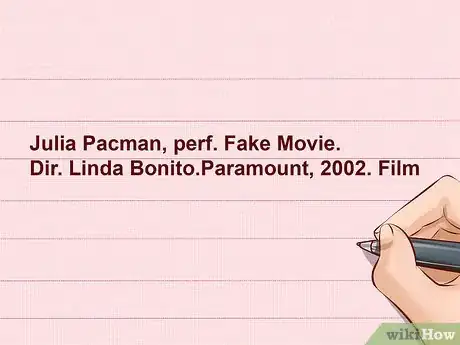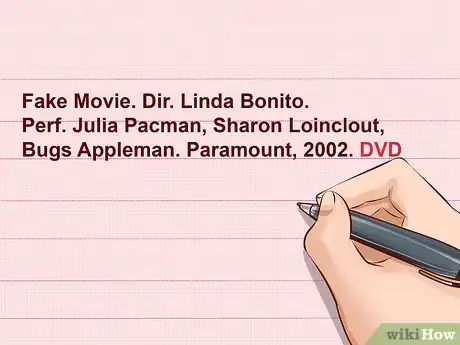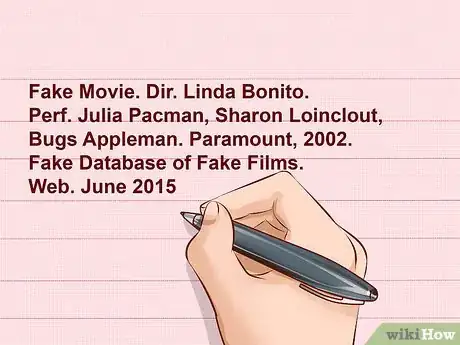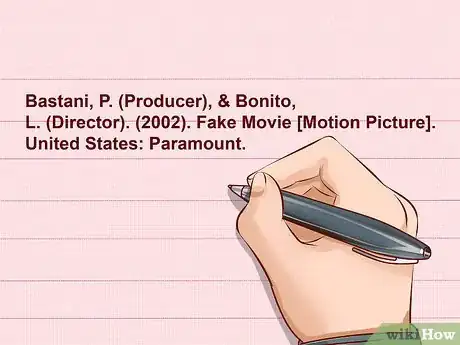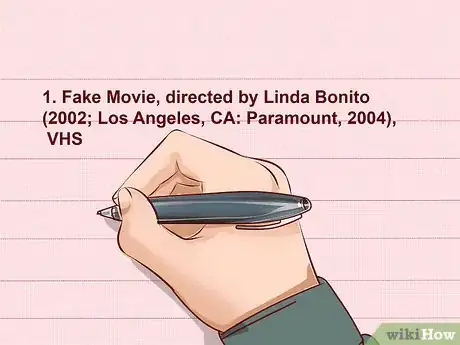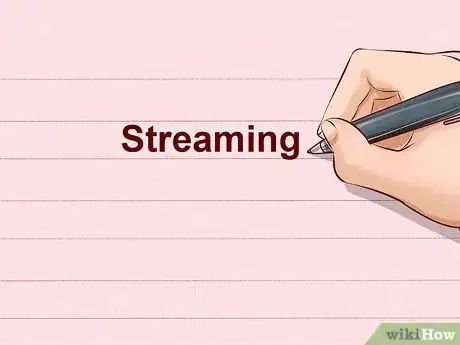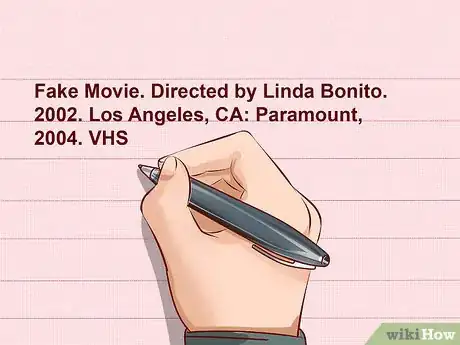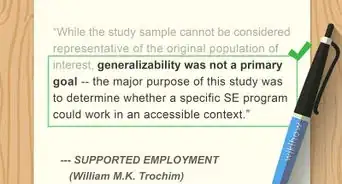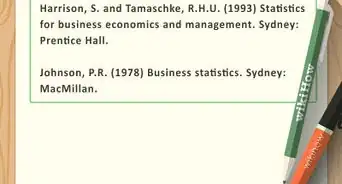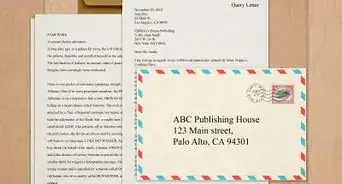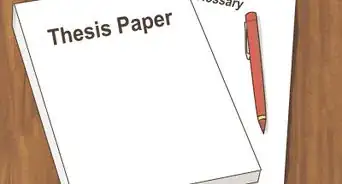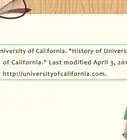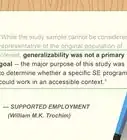This article was co-authored by wikiHow Staff. Our trained team of editors and researchers validate articles for accuracy and comprehensiveness. wikiHow's Content Management Team carefully monitors the work from our editorial staff to ensure that each article is backed by trusted research and meets our high quality standards.
This article has been viewed 39,569 times.
Learn more...
When you write a report or a paper, it's customary to include a list of sources known as a bibliography. The bibliography references the source material you used when compiling the information for the final product. Bibliographies can include books, magazines, documents, Internet sites, recordings and movies. The writer who uses movies as sources will need to know how to write a film bibliography. Ask your teacher or your editor whether you should use Chicago, MLA, or APA formatting.
Steps
Citing a Film in MLA
-
1List films by their title. Italicize the title and put it in its own sentence. Follow the title with the name of the director after the abbreviation "Dir." Then list the film studio or distributor, and the release year, each as a separate sentence. Head the list with the abbreviation "perf." Finally, cite the medium as "Film" as a standalone sentence.[1]
- "Fake Movie. Dir. Linda Bonito. Paramount, 2002. Film."
- List performer names after the director’s name if you would like to do so.
- You might write "Fake Movie. Dir. Linda Bonito. Perf. Julia Pacman, Sharon Loinclout, Bugs Appleman. Paramount, 2002. Film."
-
2List films by an actor or the director. If a director or an actor is the focus of your paper, begin your citation with their name, followed by the abbreviation "dir" or "perf." You might write: "Linda Bonito, dir. "Fake Movie. Paramount, 2002. Film."
- To emphasize an actor, you might write "Julia Pacman, perf. Fake Movie. Dir. Linda Bonito. Paramount, 2002. Film."[2]
Advertisement -
3End with the medium for DVD and VHS. If the film has been released to video or DVD, end your citation with "DVD" or "VHS" instead of "Film." For instance, if the film you watched was on DVD, you would add "DVD" as its own sentence in the citation. You might write "Fake Movie. Dir. Linda Bonito. Perf. Julia Pacman, Sharon Loinclout, Bugs Appleman. Paramount, 2002. DVD."[3]
- If you watched a video, write "VHS."
-
4Credit the websites of films you stream. If you streamed the film online, end with the website on which you accessed the film, the word "Web," and the date of access. Each of these pieces of information should be standalone sentences.
- For example, write: "Fake Movie. Dir. Linda Bonito. Perf. Julia Pacman, Sharon Loinclout, Bugs Appleman. Paramount, 2002. Fake Database of Fake Films. Web. June 2015."[4]
Citing a Film in APA
-
1List a film by its producer. Write the producer's last name, a comma, and then the first initial and a period. Then type a space, and the word "(Producer)" in parenthesis. Follow this with a comma, a space, a "&" sign, and the director's last name, a comma, the director's first initial and the word "(Director)" in parenthesis. Follow this with a comma, a space, and the year of the film's release in parenthesis.
- After this write the name of the film in italics, followed by brackets enclosing the phrase "[Motion picture]" and a period.[5]
- Follow this with the country of origin, a colon, and the studio or distributor.
- For example, write: "Bastani, P. (Producer), & Bonito, L. (Director). (2002). Fake Movie [Motion Picture]. United States: Paramount.
-
2List a film of limited availability with information on how to find it. If the movie you are citing is hard to obtain, use the same format up to the point where you write [Motion Picture]." After that, skip a space and enclose directions to getting the film in parenthesis.[6]
- You might write: "Bastani, P. (Producer), & Bonito, L. (Director). (2002). Fake Movie [Motion Picture]. (Available from University of California Irvine, Office of Obscure Feminist Film 260 Aldrich Hall Irvine, CA 92697)"
-
3Cite a streaming film beginning with the producer. Begin with the producer's full name, followed by parenthesis. In the parenthesis, write "(Producer)." Follow this with a period, then another set of parenthesis that enclose the date of the video's publication. Then write the film's title in italics, followed by a period. End with brackets that enclose the phrase"[Streaming Video]," a period, and the phrase "Retrieved from [name of database]."[7]
- For example, write: "Bastani, Penelope (Producer). (2002). Fake Movie [Streaming Video]. Retrieved from Feminist Filmstars Online database.
Citing a Film in Chicago
-
1Cite within a footnote or endnote beginning the movie title. Italicize the movie title and follow it with a comma, a space, the phrase "directed by [director's name]," and then open a parenthesis. Within the parenthesis, write the film's release year followed by a semicolon, the name of the city of its studio or distributor. Follow this with a colon and the name of the studio/distributor. Follow this with a comma and the video release year, and close with a period.[8]
- Close the parenthesis, add a comma, and write "DVD" "VHS" or "Film" if it has not been released.
- If the film has not been released to DVD or video, omit the video release year.
- You might write "1. Fake Movie, directed by Linda Bonito (2002; Los Angeles, CA: Paramount, 2004), VHS."
-
2Write "streaming" if you watched it online. Instead of finishing your citation with "DVD" "VHS" or "Film, write "Streaming." Write this as a standalone sentence. You do not have to list the source website.[9]
-
3List the corresponding bibliographical entry similarly. Begin with the italicized movie title as a standalone sentence. Follow this with the sentence "Directed by [director's name]." Follow this with the date of the film's release, and a period. Next, write the studio location, a colon, the studio name, a comma, and the video release date. Follow this with the medium, and a period.[10]
- For example, write "Fake Movie. Directed by Linda Bonito. 2002. Los Angeles, CA: Paramount, 2004. VHS."
References
- ↑ https://owl.english.purdue.edu/owl/resource/747/09/
- ↑ https://owl.english.purdue.edu/owl/resource/747/09/
- ↑ https://owl.english.purdue.edu/owl/resource/747/09/
- ↑ http://libguides.library.cofc.edu/c.php?g=230859&p=1531533
- ↑ https://owl.english.purdue.edu/owl/resource/560/11/
- ↑ https://owl.english.purdue.edu/owl/resource/560/11/
- ↑ http://libguides.library.cofc.edu/c.php?g=230859&p=1531533
- ↑ https://owl.english.purdue.edu/owl/resource/717/06/
- ↑ https://library.osu.edu/documents/english/FINALlibrary_CMS.pdf

